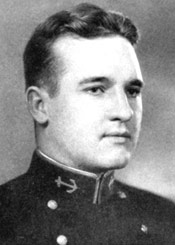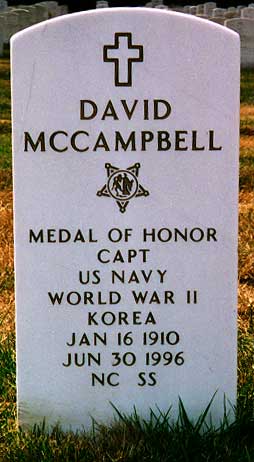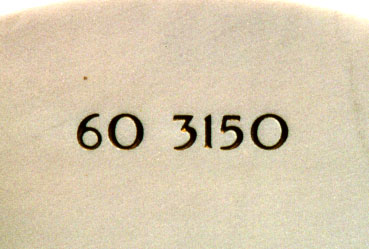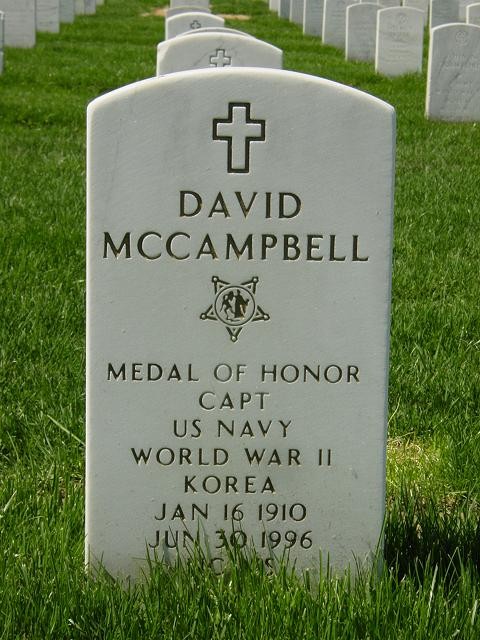Veteran pushes to honor ace pilot
Courtesy of the Palm Beach Post
Monday, March 22, 2004
Big Jim Gregory served with David McCampbell, the top U.S. Navy fighter pilot ever. He persuaded politicians to name the terminal at Palm Beach International Airport for the “Ace of Aces,” a lifelong Palm Beach County resident, and was on hand when a ship named for McCampbell was christened in Maine in 2000.
Now Gregory is on a new mission. He wants the classroom building at the Navy’s “Top Gun” school in Nevada to be named for McCampbell.
“What else do you name a Top Gun school after but a Top Gun ace?” said the 79-year-old Lake Clarke Shores resident and owner of a West Palm Beach coffee service.
The base in Miramar, California, that hosted the famous “Top Gun” school was closed in 1986 and the property was turned over to the U.S. Marines. The school moved to a 241,000-acre base in Fallon, Nevada, about 60 miles east of Reno.
That base’s airfield was named in 1958 for Bruce Van Voorhis, Nevada’s only Medal of Honor recipient. But the academic building, built in 1995, doesn’t have a name.
“It would be fitting to the name the building after such a distinguished naval aviator,” base spokesman Patrick Lane said. “But we have to deal with the chain of command. We’re researching just exactly what it takes and whether it needs to be registered.”
McCampbell, an Alabama native who had moved to West Palm Beach as a youngster when his father opened a furniture business, died at 86 in 1996 and was buried at Arlington National Cemetery.
During World War II, newspapers and magazines across America showed the grin of the Navy captain who, during a seven-month span in 1944, recorded 34 kills and destroyed 24 planes on the ground in the battles of the Philippine Sea and Leyte Gulf.
In the Leyte Gulf battle, the USS Honolulu was the first ship torpedoed, and it was dead in the water for four days. Gregory, who was a 19-year-old engineer stationed in the boiler room, contends the Japanese Zeros would easily have finished off the Honolulu if not for the exploits of McCampbell and his colleagues.
“His fame is resting on the fact that he was such a ferocious pilot,” Hank McCall said of McCampbell, “and absolutely fearless.”
McCall, an 82-year-old retired West Palm Beach life insurance agent who was a submarine officer during World War II, lectures about McCampbell, most recently on March 4 for the Historical Society of Palm Beach County.
McCampbell’s nine kills in 90 minutes set a record in aerial warfare history for a single mission that is believed to stand today. He is the nation’s top Navy ace and fourth-leading ace, behind three Army Air Force pilots.
He was the top ace to survive the war. He received the Medal of Honor, the Navy Cross, three Distinguished Flying Crosses, the Legion of Merit, the Silver Star and the Air Medal.
“I brag about the planes I shot down, but I don’t brag about the number of people I killed,” McCampbell said during a 1992 interview. “For 32 years, all I did was try to forget all of it.”
From a contemporary press report: 4 July 1996
David McCampbell, 86, the Navy’s all-time leading ace with 34 aerial victories during World War II and medals including the Medal of Honor, the nation’s highest award for valor, died June 30, 1996 in a nursing home in Rivera Beach Florida. The cause of death was not reported.
United States Naval Academy Photo
In 1944, Captain McCampbell was commander of Air Group 15, in charge of fighters, bombers and torpedo bombers aboard the aircraft carrier Essex. His squadron saw almost six months of continuous combat and participated in two major air-sea battles, the first and second battles of the Philippine Sea.
In October 1944, Captain McCampbell shot down nine enemy planes in one mission. “I just kept on shooting,” he said. When he landed his Grumman Hellcat, his six machine guns had two rounds remaining and the plane had only enough fuel to keep it aloft for 10 more minutes.
Captain McCampbell received the Medal of Honor for that action and for similar exploits in June 1944, in which his planes routed a larger enemy force and in which he got seven kills.
Referring to the October fight, the citation for the Medal of Honor pointed out that “during a major fleet engagement . . . assisted by but one plane, [Captain McCampbell] intercepted and daringly attacked a formation of 60 hostile land-based craft approaching our forces. Fighting desperately but with superb skill against such overwhelming air power, he shot down nine Japanese planes and, completely disorganizing the enemy group, forced the remainder to abandon the attack before a single aircraft could reach the fleet.” Captain McCampbell’s 34 victories made him the armed services’ fourth-leading ace of all time behind three Army Air Forces pilots: Major Richard I. Bong, who had 40 kills; Major Thomas McGuire, 38; and Colonel Francis S. Gabreski, 34.5. Victories are divided if more than one pilot is credited with shooting down a plane.
In addition to the nation’s highest military honor, Captain McCampbell’s awards included the Navy Cross, the Navy’s second-highest award for valor; a Silver Star; and the Distinguished Flying Cross.
After the war, his assignments included command of the carrier Bon Homme Richard and a stint as plans division chief of the Joint Chiefs of Staff. He retired from active duty in 1964.
Captain McCampbell, who was born in Bessemer, Alabama, grew up in West Palm Beach, Florida. He attended Staunton Military Academy in Virginia and Georgia Tech in Atlanta before being appointed to the U.S. Naval Academy at Annapolis. There, he was a champion swimmer and diver, and he graduated with a degree in marine engineering in 1933.
McCAMPBELL, DAVID
Rank and organization: Commander, U.S. Navy, Air Group 15. Place and date: First and second battles of the Philippine Sea, 19 June 1944. Entered service at: Florida. Born: 16 January 1 910, Bessemer, Alabama. Other Navy awards: Navy Cross, Silver Star, Legion of Merit, Distinguished Flying Cross with 2 Gold Stars, Air Medal.
Citation:
For conspicuous gallantry and intrepidity at the risk of his life above and beyond the call of duty as commander, Air Group 15, during combat against enemy Japanese aerial forces in the first and second battles of the Philippine Sea. An inspiring leader, fighting boldly in the face of terrific odds, Comdr. McCampbell led his fighter planes against a force of 80 Japanese carrier-based aircraft bearing down on our fleet on 19 June 1944. Striking fiercely in valiant defense of our surface force, he personally destroyed 7 hostile planes during this single engagement in which the outnumbering attack force was utterly routed and virtually annihilated. During a major fleet engagement with the enemy on 24 October, Comdr. McCampbell, assisted by but one plane, intercepted and daringly attacked a formation of 60 hostile land-based craft approaching our forces. Fighting desperately but with superb skill against such overwhelming airpower, he shot down 9 Japanese planes and, completely disorganizing the enemy group, forced the remainder to abandon the attack before a single aircraft could reach the fleet. His great personal valor and indomitable spirit of aggression under extremely perilous combat conditions reflect the highest credit upon Comdr. McCampbell and the U.S. Naval Service.
Michael Robert Patterson was born in Arlington and is the son of a former officer of the US Army. So it was no wonder that sooner or later his interests drew him to American history and especially to American military history. Many of his articles can be found on renowned portals like the New York Times, Washingtonpost or Wikipedia.
Reviewed by: Michael Howard




